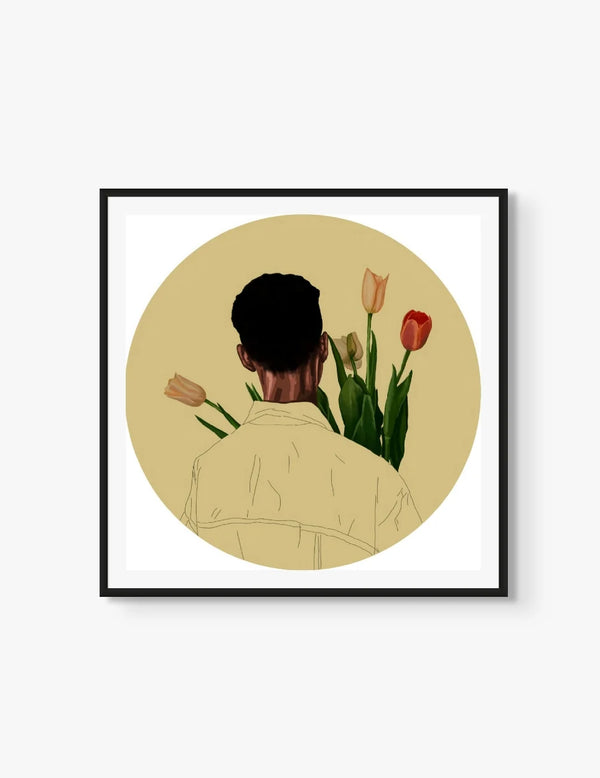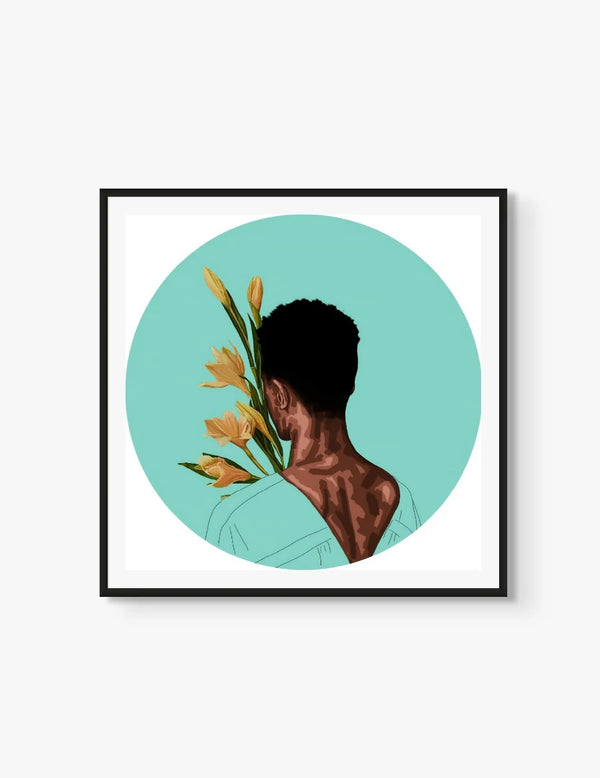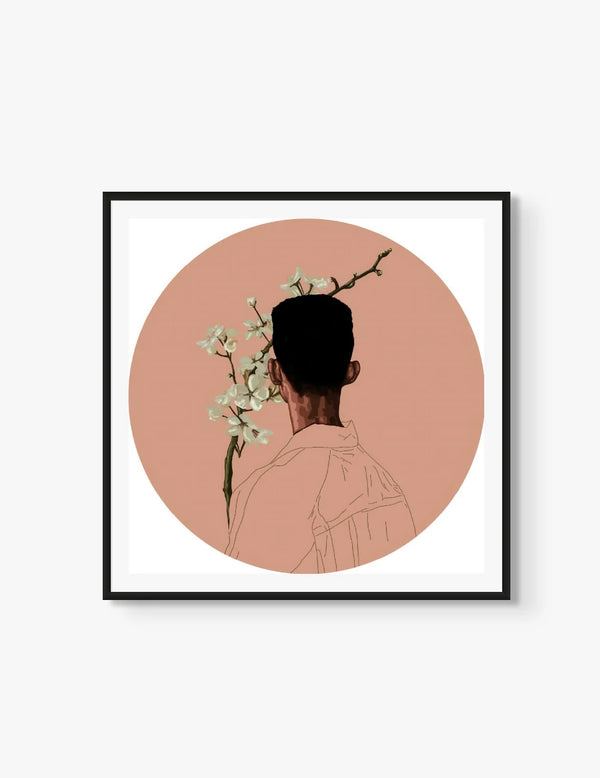In Conversation With Oluwatobiloba Fasalejo

"My process of painting wholly has to do with myself, my environment, my people." - Oluwatobiloba, "Tobi", Fasalejo
In the southwestern Ondo State of Nigeria, nicknamed the “Sunshine State,” aspiring artist Oluwatobiloba Fasalejo is shedding light on the vibrant contemporary African art scene. Emerging as a voice of resilience, adaptability, and artistic expression, Fasalejo captures the personal and collective experiences of his environment through his work. In this revealing conversation, we reflect on Fasalejo’s journey, challenges, and aspirations. We explore themes of resilience and self-acceptance, and how his environment shapes him as an artist.
From Uncertainty to Expression: Oluwatobiloba Fasalejo’s Artistic Beginnings
While many artists set out with a clear vision of their creative path, Fasalejo’s journey into art was guided by discovery rather than design. For him, becoming an artist was not something planned – it was something discovered through self-exploration. He recalls that while his siblings had clearly defined career paths, he was still finding his own direction: "I come from a family of six, being the second-to-last born of four children. [Some of] my siblings wanted to be doctors, some lawyers," he explains. "I found myself in a position where I didn’t know what I wanted to do. The only thing I knew was that I had a passion for art, and I didn’t even know where the art would take me."
The turning point for Fasalejo came when his family challenged him to find his own direction and purpose in life. He then began creating African art paintings for sale in his local community, uncertain of where it might lead. “I also started receiving prizes for my art around this time. Some people paid me well, and I received praise and appreciation.” That recognition encouraged him to keep going, “I continued pursuing art, and then my family started seeing I was doing something that was reasonable. From that point on, I started doing art professionally.”
Drawing Inspiration from One’s Environment

For Fasalejo, his environment has always been a driving force behind his work. Growing up in Ondo State, he found inspiration in the community-oriented lifestyle, where a mix of traditional values, natural beauty, and a growing urban presence influences everyday life. “Apart from thinking about what I want to create, when I go out and meet people and talk to the people in my environment, I derive a source of inspiration,” he notes. “My artwork is not my experience alone. It also has to do with the experiences of people in my environment that resonate with me and with others as well.”
While Ondo State shaped Fasalejo’s creative outlook, it also came with limitations. Nigeria’s art scene tends to gravitate toward Lagos and Abuja – metropolitan hubs where galleries, collectors, and curators are more accessible, and where opportunities are easier to come by. For emerging contemporary artists based outside these urban centres, gaining visibility is often a battle. “There are times that I feel like I shouldn’t create because of the challenges I face in my line of work,” he admits. “But when I see the things that are happening in my environment, I see that there’s a lot of work that I need to do."
However, even in the face of frustration, Fasalejo returns to his canvas, driven by ambition and a sense of responsibility, “It just gives me that immediate motivation that makes me want to create all over again,” he says about the limitations of his environment, “Especially when I see the challenges that my people are going through. It is one thing to see what is happening, but it is another thing to experience that same challenge,” he says with conviction. “There have been enough occasions when I’ve experienced the challenges in my environment, which gives me a sense of inspiration to keep pushing forward.”
Like many emerging contemporary artists, Fasalejo faces obstacles when trying to expand his reach. “One of the challenges that I face currently is getting people to appreciate my art, and getting a global audience to be able to see what I am doing and to be able to learn from my story.” As an international platform and online art gallery, Artamine offers a solution to this obstacle by connecting emerging African artists like Fasalejo with a global audience that values and appreciates their work, making their artwork more accessible to collectors worldwide.
Fasalejo’s work has already started gaining international attention. His first exhibition outside Nigeria was in Nairobi, Kenya. It was featured in the Business Daily Africa Newspaper, a major milestone for the young artist. Since then, his work has been displayed in various galleries, and he has been interviewed by TRT Africa, Shout Out Miami, and Subo Art Magazine.
Behind the Canvas: The Art of Resilience

"Becoming Blossom", Flower Boy, Oluwatobiloba Fasalejo
Two of the strongest themes in Fasalejo’s work are resilience and adaptability, or “the ability to adapt to your present situation,” as he describes it. That mindset is not theoretical – it is something he has lived: “The theme of resilience is inspired by me, myself, and my family, my environment,” he explains. “How we have been able to struggle and move from having nothing to managing with the little that we have.”
This mindset shapes his creative process and the meaning behind each piece. Though naturally reserved, Fasalejo’s quiet resolve speaks volumes. Rather than let this deter him, Fasalejo lets it fuel him. “When I am not getting the total attention of people, I go back to my studio and work harder,” he says. The creative process becomes a quiet act of resistance, rooted in purpose. His series, Flower Boy, for example, explores themes of transformation and self-acceptance. “It has to do with a boy discovering himself and his challenges,” he explains. Through vibrant colours and natural motifs like flowers, Fasalejo visualises growth, survival, and the subtle beauty that can emerge from hardship. “It generally has to do with me personally: how I've been able to discover myself within the challenges in my environment.”
This commitment to personal storytelling also carries a broader message. In sharing his journey, he invites others to find strength in theirs. “There’s a particular story, a strong story, that comes with my work which gives me confidence,” he says. “So, it’s not just creating for creating’s sake – this builds my confidence.”
Mentorship and Community for the African Art Scene
While Fasalejo’s art is deeply personal, it is never limited to his own story. His creative practice has always been about more than self-expression – it is about connection and contribution. He believes that artists have a role to play in building stronger communities, especially in places where creative infrastructure is limited. “One of my dreams is to have an art community here in my local environment that is able to foster the growth of common artists here,” he explains. “And for me personally, I want to have this kind of community whereby I can mentor people.”
His motivation is rooted in a desire to create what he wishes he had had when he started out: guidance, visibility, and a shared space to grow. “There are a lot of people in my environment that do not even know what they want to do with their lives,” he adds. “I feel like I could create a community or organisation that would mentor them and teach them the right way of going with their life… so that we can build the environment together.”
Though not currently part of a formal collective, he has seen the power of artist networks elsewhere. “There are several ones in Lagos, which have pushed Nigerian artists to the global space,” he says, referencing the support structures that exist in larger cities. “They have done wonderful things like creating workshops, exhibitions, and providing artists with the material they need to work.” It is a model he would love to bring home, tailored to his own community.
Looking Ahead: A Vision for the Future of African Fine Art

Fasalejo’s vision extends far beyond his own canvas. His next chapter is about expansion – artistically, professionally, and globally. Like many emerging African artists, Fasalejo faces obstacles when trying to expand his reach. “One of the challenges that I face currently is getting people to appreciate my art and getting a global audience to be able to see what I am doing and to be able to learn from my story.”
Still, his work has already started gaining international attention. His first exhibition outside Nigeria was in Nairobi, Kenya, featured in the Business Daily Africa Newspaper—a major milestone for the young artist. Since then, his work has been displayed in various galleries, and he has been interviewed by TRT Africa, Shout Out Miami, and Subo Art Magazine.
Despite this growing visibility, he understands that building a sustainable career takes time and patience. “One valuable lesson I’ve learned is that I should take my career a step at a time,” he reflects. “It’s not all going to come at once, so I just have to take it a step at a time.”
His collaboration with Artamine reflects this steady, purposeful move toward broader visibility. “Creating more visibility for me and my [art prints] is one thing that is going to benefit me from the partnership,” he says. “Putting my work in the global space so I can have more people and a bigger audience learning from my story and being able to share it with more people.
When asked who he would love to collaborate with, Fasalejo does not hesitate. “An artist from Ghana, Amoako Boafo,” he says. “The story he is pushing out to the global space is something that resonates with me, and that is very similar to my personal story… I would appreciate a collaboration with him.”
Ultimately, Fasalejo sees African artists as increasingly vital voices on the global stage – voices with stories the world is finally ready to hear. “Africa itself is going to be a global space in the coming years,” he says. “Because of the things that have been happening and the unseen stories of people that are now seen.”
Advice for Other Emerging African Artists
Whether he is telling his own story or amplifying the voices of others, Oluwatobiloba Fasalejo’s premium paintings reflect a deeper mission: to create, to connect, and to contribute. As he continues to grow and reach new audiences, one thing remains clear: his story is still unfolding, and the world is beginning to listen. His advice to other emerging contemporary artists is simple but sincere: “Be hardworking. If this is something you love to do, do everything to become successful with it… be resilient enough to push through.”



